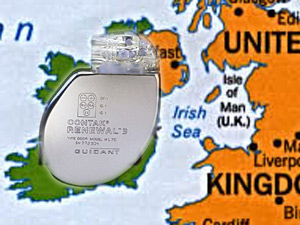|
Audio
Photos
More from MPR
Resources
Your Voice
|
Getting to the "heart" of Minnesota's Irish connection
July 11, 2004
When you look at the countries where Minnesota sends its exports, something is noticeably out-of-whack. Canada is our No. 1 trading partner -- that's no surprise. But second on the list -- far above major economies like Japan, Mexico, and Germany -- is a country most people wouldn't expect. It's Ireland, a pastoral island with a population a little bigger than Oklahoma.
Arden Hills, Minn. — There is clearly something unusual going on here.
In the past five years Minnesota's exports to Ireland are up 200 percent, to more than $1.2 billion. That puts our Irish exports above any other state in the country, including California -- a state that, overall, exports more than eight times as much as we do.
 | |||
The explanation is not immediatly apparent. More than 80 percent of the Irish exports fall in a category labeled, "miscellaneous." State economic analyst Bob Isaacson, with the Department of Employment and Economic Analysis, was happy to join in a little of what he calls "DEED forensics."
First off, given the size and speed of the export jump, it's unlikely the Irish people suddenly developed a taste for Grainbelt beer or Minnesota wild rice.
"You knew it wasn't being driven by the Ireland demographics," Isaacson says. "When you see this type of increase or spike to Ireland, you knew it was some kind of inter-company shipment -- at least it suggested that."
Partially completed goods shipped from one company to another -- or even within a single company -- will show up in the export numbers. So what industry, shipping miscellaneous products, could shoot one small country near the top of our list of trading partners?
"For Minnesota, one of those miscellaneous industries is quite large," Isaacson says. "And that is medical products."
 | |||
Specifically, medical devices like pacemakers and implantable defibrillators that shock the heart back into rhythm. The Irish aren't using them -- they're putting them together.
Enter the factory floor of Guidant Corp., in the Twin Cities suburb of Arden Hills. At the time of this visit, workers are testing and packaging the circuit board of what's called a "heart resynchronization device" -- something like a combination pacemaker and defibrillator.
In 1998, Guidant bought a factory in Clonmel, Ireland to do final assembly for its cardiac rhythm devices. That factory now has more than 1,000 employees. The company won't say just how many half-finished devices it sends in its daily shipments to Clonmel, but Guidant is likely the main force behind Minnesota's unusual export numbers. This year its cardiac rhythm division expects $2.4 billion in sales. More than 95 percent of those devices will travel to Ireland.
And most of them -- 80 percent -- will come right back, destined for the chests of Americans. In that case, why go to Ireland in the first place?
 | |||
Guidant vice president of manufacturing Randy Doyle says in the late '90s, the company couldn't find enough Minnesotans to work second or third shifts. Ireland offered a well-educated but idle workforce -- unemployment at the time was pushing 10 percent there.
The Irish government was also willing to help out, including, "grants in aid to help start your facilities, and the advantage of taxation less than that you would pick up in the U.S. or some of the other locales you may look at," Doyle says.
Guidant pays Irish corporate income taxes of 10 percent -- compared with a 35 percent federal tax rate and 9.8 percent state tax rate here.
By courting companies like Guidant, Medtronic, and Boston Scientific, Ireland has emerged as a medical device center. In its promotional materials, the country now compares itself with...Minnesota.
Medtronic has had a factory in Galway since 1982, and now makes stents and other vascular products there. Boston Scientific has four separate campuses in Ireland. Unlike Guidant, however, both companies say their Ireland operations are largely self-sufficient, which means a much smaller volume of goods going across the ocean.
All this activity, and the attractiveness of Ireland, make it look like we might be exporting jobs along with defibrillator circuit boards. Not necessarily, says state economic analyst Bob Isaacson.
"If they can use an Ireland workforce to do some final assembly, that ultimately frees up resources in Minnesota to do the higher value-added research and development, and other highly value-added manufacturing," Isaacson says. "That makes for a more competitive company, a healthier company, and better and stable jobs for Minnesotans."
In this case, the numbers back up this more positive view of offshore labor. In the past two years, Guidant has increased spending on research and development by 43 percent -- much of which supports the R&D labs in Arden Hills. Since 1998, when Guidant expanded to Ireland, its U.S. workforce is up 60 percent.
Guidant plans another 1,000 jobs in Ireland over the next few years, this time making its drug-coated stent. It makes sense to expand a trade relationship that so far has both sides seeing green.
|
News Headlines
|
Related Subjects
|

